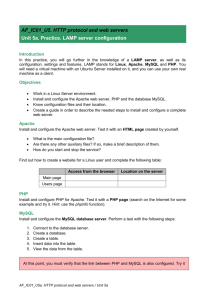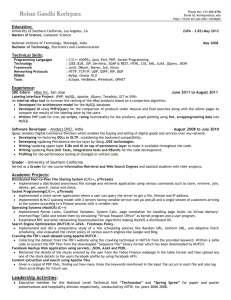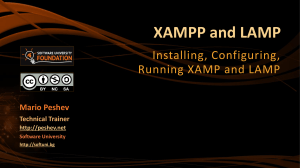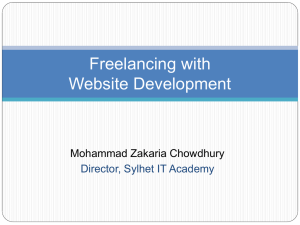Syllabus
advertisement
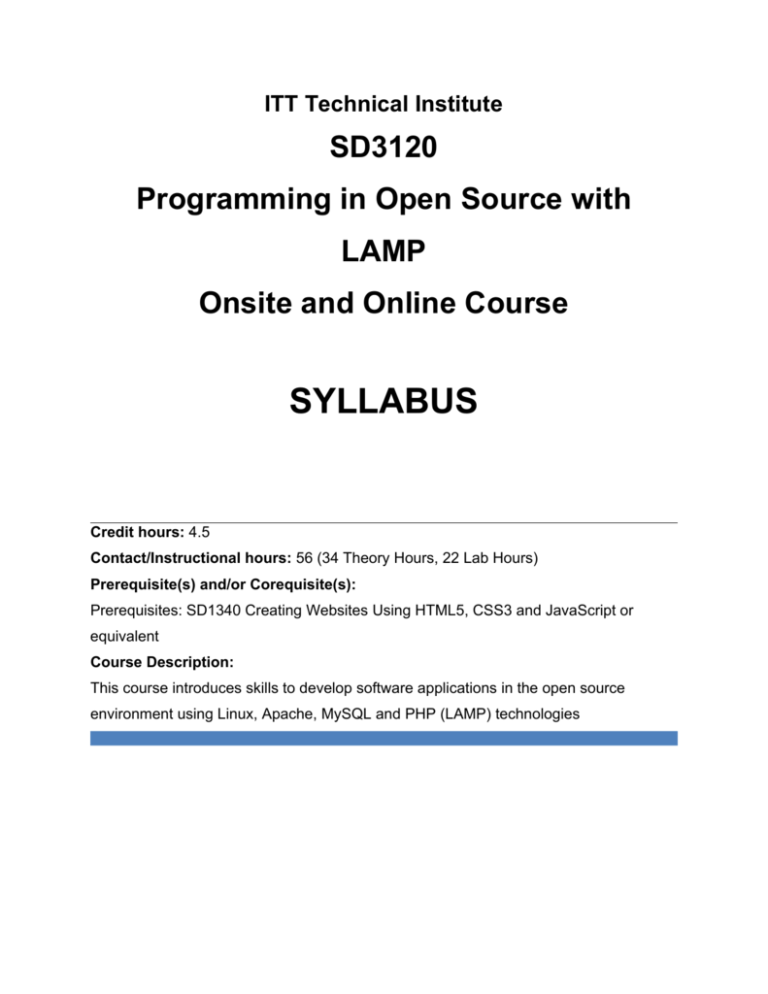
ITT Technical Institute SD3120 Programming in Open Source with LAMP Onsite and Online Course SYLLABUS Credit hours: 4.5 Contact/Instructional hours: 56 (34 Theory Hours, 22 Lab Hours) Prerequisite(s) and/or Corequisite(s): Prerequisites: SD1340 Creating Websites Using HTML5, CSS3 and JavaScript or equivalent Course Description: This course introduces skills to develop software applications in the open source environment using Linux, Apache, MySQL and PHP (LAMP) technologies Programming in Open Source with LAMP Syllabus COURSE SUMMARY COURSE DESCRIPTION This course introduces skills to develop software applications in the open source environment using Linux, Apache, MySQL and PHP (LAMP) technologies. MAJOR INSTRUCTIONAL AREAS 1. Use of LAMP platform and an open source IDE to create Web applications 2. Fundamental tasks required to configure a computer running Linux as a development platform 3. Basic Apache Web server configuration techniques 4. Database creation using MySQL 5. Introduction to Web application development using PHP 6. Introduction to Perl and Python COURSE LEARNING OBJECTIVES By the end of this course, you should be able to: 1. Describe fundamental Web technologies and the HTML markup language. 2. Operate and develop effectively within a Linux environment. 3. Configure Apache Web server to host a Web site. 4. Enhance Web applications through server-side scripting. 5. Create a Web application using PHP. 6. Apply object-oriented programming techniques using PHP. 7. Create a Web application that accesses a MySQL database. 8. Handle errors and exceptions in PHP. 9. Manage Web session state in PHP. 10.Describe the best practices for securing a server. COURSE OUTLINE MODULE 1: INTRODUCING THE WEB AND HTML 1 Date: 7/21/2014 Programming in Open Source with LAMP Syllabus COURSE LEARNING OBJECTIVES COVERED Describe fundamental Web technologies and the HTML markup language. Operate and develop effectively within a Linux environment. TOPICS COVERED Internet Protocol and the Client-Server Model Hypertext Transfer Protocol (HTTP) and Web Servers Hypertext Markup Language (HTML) Syntax, Elements, and Documents HTML Documents, Tables, Forms, and Form Control Elements Fundamentals of Perl and Perl Common Gateway Interface (CGI) Programming GRADE OUT-OF- D CLASS TIME No 6.5 hr No 1.5 hr No 1 hr Servers.” Yes N/A Lab: Complete the lab titled “Setting Up the Eclipse.” Yes N/A Project: Read and begin the project. No 0.5 hr MODULE LEARNING ACTIVITIES Reading: Connolly, R., & Hoar, R., Chapter 1, pp. 2–29 and pp. 40–48, Chapter 2, pp. 53–80, and Chapter 4, pp. 149–173 Reading: ITT Tech Virtual Library> Basic Search> Browse> Browse by Format> Books> Books24x7> Perl and Apache: Your Visual Blueprint for Developing Dynamic Web Content> Chapter 6, Sections 6.1–6.5 and Chapter 8, Sections 8.1–8.5 Lesson: Study the lesson for this module. Discussion: Participate in the discussion titled “Exploring Different Total Out-Of-Class Activities: 9.5 Hours 2 Date: 7/21/2014 Programming in Open Source with LAMP Syllabus MODULE 2: ADMINISTERING APACHE IN THE LINUX ENVIRONMENT COURSE LEARNING OBJECTIVES COVERED Operate and develop effectively within a Linux environment. Configure Apache Web server to host a Web site. TOPICS COVERED Web Server—Hosting Options and Domain and Name Server Administration Linux and Apache Configuration Apache Request and Response Management Web Monitoring and Analytics Installation, Use, and Administration of Linux Installation of Perl and Apache on Linux MODULE LEARNING ACTIVITIES Reading: Connolly, R., & Hoar, R., Chapter 19, pp. 839–875 GRADE D OUT-OFCLASS TIME No 4 hr No 9 hr Lesson: Study the lesson for this module. No 2 hr Quiz: Prepare for Quiz 1. No 1.5 hr Server.” Yes N/A Lab 1: Complete the lab titled “Explore the Fedora Operating System.” Yes N/A Lab 2: Complete the lab titled “Manage Content on Apache.” Yes N/A Quiz: Take Quiz 1. Yes N/A Project: Continue work on Project Part 1. No 1 hr Reading: ITT Tech Virtual Library> Basic Search> Browse> Browse by Format> Books> Books24x7> Setting Up LAMP: Getting Linux, Apache, MySQL, and PHP Working Together> Chapter 2, Sections 2.1–2.6, Chapter 3, Section 3.3, and Chapter 4, Sections 4.2–4.3 Perl and Apache: Your Visual Blueprint for Developing Dynamic Web Content> Chapter 3 and Chapter 5 Discussion: Participate in the discussion titled “Apache Open Source Web 3 Date: 7/21/2014 Programming in Open Source with LAMP Syllabus Total Out-Of-Class Activities: 17.5 Hours 4 Date: 7/21/2014 Programming in Open Source with LAMP Syllabus MODULE 3: USING PHP FOR WEB DEVELOPMENT COURSE LEARNING OBJECTIVES COVERED Enhance Web applications through server-side scripting. Create a Web application using PHP. Apply object-oriented programming techniques using PHP. TOPICS COVERED Server-Side Development Responsibility of a Web Server Introduction to PHP, Installation, and Configuration Program Control PHP Functions, Arrays, and Superglobals Classes and Objects in PHP GRADE OUT-OF- D CLASS TIME No 10 hr No 2 hr Lesson: Study the lesson for this module. No 2 hr Quiz: Prepare for Quiz 2. No 1.5 hr Discussion: Participate in the discussion titled “Server-Side Scripting.” Yes N/A Lab 1: Complete the lab titled “Write a PHP Script to Process a Form.” Yes N/A Lab 2: Complete the lab titled “Implement a Contest-Checking Site.” Yes N/A Quiz: Take Quiz 2. Yes N/A Project: Continue work on Project Part 1. No 2 hr MODULE LEARNING ACTIVITIES Reading: Connolly, R., & Hoar, R., Chapter 8, pp. 323–358, Chapter 9, pp. 365–391, and Chapter 10, pp. 403–432 Reading: ITT Tech Virtual Library> Basic Search> Browse> Browse by Format> Books> Books24x7>Setting Up LAMP: Getting Linux, Apache, MySQL, and PHP Working Together> Chapter 10, Sections 10.1–10.4 Total Out-Of-Class Activities: 17.5 Hours 5 Date: 7/21/2014 Programming in Open Source with LAMP Syllabus MODULE 4: WORKING WITH THE DATABASE COURSE LEARNING OBJECTIVES COVERED Enhance Web applications through server-side scripting. Create a Web application using PHP. Apply object-oriented programming techniques using PHP. Create a Web application that accesses a MySQL database. TOPICS COVERED Database and Web Development SQL Database APIs MySQL Database Management PHP Programming in MySQL MySQL Installation and Administration Simple Database Techniques GRADE OUT-OF- D CLASS TIME No 6.5 hr No 4 hr Lesson: Study the lesson for this module. No 2 hr Quiz: Prepare for Quiz 3. No 1.5 hr Discussion: Participate in the discussion titled “Common Security Flaws.” Yes N/A Lab: Complete the lab titled “Create and Access a Database.” Yes N/A Quiz: Take Quiz 3. Yes N/A Project: Submit Project Part 1. Yes 3 hr MODULE LEARNING ACTIVITIES Reading: Connolly, R., & Hoar, R., Chapter 11, pp. 437–495 Reading: ITT Tech Virtual Library> Basic Search> Browse> Browse by Format> Books> Books24x7> Setting Up LAMP: Getting Linux, Apache, MySQL, and PHP Working Together> Chapter 9, Sections 9.1–9.6 Total Out-Of-Class Activities: 17 Hours MODULE 5: HANDLING ERRORS, EXCEPTIONS, AND MANAGING STATES COURSE LEARNING OBJECTIVES COVERED 6 Date: 7/21/2014 Programming in Open Source with LAMP Syllabus Enhance Web applications through server-side scripting. Create a Web application using PHP. Apply object-oriented programming techniques using PHP. Create a Web application that accesses a MySQL database. Handle errors and exceptions in PHP. Manage Web session state in PHP. TOPICS COVERED Errors and Exceptions PHP Error, Error Reporting, and Exception Handling Regular Expressions User Input Validation State in Web Applications Cookies, Serialization, and Session State HTML5 Web Storage and Caching MODULE LEARNING ACTIVITIES GRADE D OUT-OFCLASS TIME Reading: Connolly, R., & Hoar, R., Chapter 12, pp. 504–536, and Chapter 13, pp. 542–567 No 6.5 hr Lesson: Study the lesson for this module. No 1.5 hr Discussion: Participate in the discussion titled “Reducing Validation Errors.” Yes 1.5 hr Quiz: Prepare for Quiz 4. No 1.5 hr Lab 1: Complete the lab titled “Create a Number-Guessing Application.” Yes N/A Lab 2: Complete the lab titled “Create a Paging Application.” Yes N/A Quiz: Take Quiz 4. Yes N/A Project: Continue work on Project Part 2. No 3 hr Final Exam: Prepare for the final exam. No 5 hr Total Out-Of-Class Activities: 19 Hours MODULE 6: SECURING THE SERVER COURSE LEARNING OBJECTIVES COVERED Create a Web application using PHP. Apply object-oriented programming techniques using PHP. Create a Web application that accesses a MySQL database. 7 Date: 7/21/2014 Programming in Open Source with LAMP Syllabus Describe the best practices for securing a server. TOPICS COVERED Server Security and Authentication Cryptography Hypertext Transfer Protocol Secure (HTTPS) Security Best Practices Common Threat Vectors Introduction to Python Penetration Testing with Python MODULE LEARNING ACTIVITIES Reading: Connolly, R., & Hoar, R., Chapter 16, pp. 666–712 GRADE D OUT-OFCLASS TIME No 4 hr No 1.5 hr Lesson: Study the lesson for this module. No 1 hr Project: Submit Project Part 2. Yes 2 hr Final Exam: Take the final exam. Yes N/A Reading: ITT Tech Virtual Library> Basic Search> Browse> Browse by Format> Books> Books24X7>Violent Python: A Cookbook For Hackers, Forensic Analysts, Penetration Testers And Security Engineers> Chapter 1, Sections 1.1–1.6, and Chapter 2, Sections 2.1–2.3 Total Out-Of-Class Activities: 8.5 Hours EVALUATION AND GRADING EVALUATION CRITERIA The graded assignments will be evaluated using the following weighted categories: CATEGORY Lab WEIGHT 25% 8 Date: 7/21/2014 Programming in Open Source with LAMP CATEGORY Syllabus WEIGHT Discussion 15% Quiz 10% Project 30% Final Exam 20% TOTAL 100% GRADE CONVERSION The final grades will be calculated from the percentages earned in the course, as follows: GRADE A (4.0 PERCENTA GE 90–100% ) B+ (3.5 85–89% ) B (3.0 80–84% ) C+ (2.5 75–79% ) C (2.0 70–74% ) D+ (1.5 65–69% ) D (1.0 60–64% ) F (0.0 <60% ) LEARNING MATERIALS AND REFERENCES REQUIRED RESOURCES 9 Date: 7/21/2014 Programming in Open Source with LAMP Syllabus COMPLETE TEXTBOOK PACKAGE Connolly, R., & Hoar, R. (2015). Fundamentals of web development (1st ed.). Upper Saddle River, NJ: Pearson. OTHER ITEMS Windows XP (or later) VMWare Player 5.2 (or later) Fedora 20 Virtual Machine Apache 2.0 Eclipse IDE for Java EE Developers Eclipse PHP Development Tools (PDT) Note: You can download Windows XP and VMware Player, from the DreamSpark website. Refer to the DreamSpark Installation Guide for download instructions. RECOMMENDED RESOURCES ITT Tech Virtual Library (accessed via Student Portal | https://studentportal.itt-tech.edu) o Basic Search> Browse> Browse by Format> Books> Books24X7> Boronczyk, T. (2009). Beginning PHP6, Apache, MySQL Web Development. Indianapolis, IN: John Wiley. Harris, A.B. (2009). PHP 6/MySQL Programming for the Absolute Beginner. Boston, MA: Cengage Learning. Mathew, N., & Stones, R. (2008). Beginning Linux Programming (4th ed.). Indianapolis, IN: John Wiley. McDaniel, A. (2010). Perl and Apache: Your Visual Blueprint for Developing Dynamic Web Content. Indianapolis, IN: John Wiley. O'Connor, TJ. (2013). Violent Python: A Cookbook for Hackers, Forensic Analysts, Penetration Testers and Security Engineers. Waltham, MA: Syngress Publishing. Rosebrock, E., & Filson, E. (2004). Setting Up LAMP: Getting Linux, Apache, MySQL, and PHP Working Together. Alameda, CA: Sybex. Soyinka, W. (2009). Linux Administration: A Beginner’s Guide (5th ed.). McGraw-Hill/Osborne. 10 Date: 7/21/2014 Programming in Open Source with LAMP Syllabus Valade, J. (2010). PHP & MySQL For Dummies (4th ed.). Indianapolis, IN: John Wiley. Vaswani, V. (2007). PHP Programming Solutions. McGraw-Hill/Osborne. 11 Date: 7/21/2014 Programming in Open Source with LAMP Syllabus INSTRUCTIONAL METHODS AND TEACHING STRATEGIES The curriculum employs a variety of instructional methods that support the course objectives while fostering higher cognitive skills. These methods are designed to encourage and engage you in the learning process in order to maximize learning opportunities. The instructional methods include but are not limited to lectures, collaborative learning options, use of technology, and hands-on activities. To implement the above-mentioned instructional methods, this course uses several teaching strategies, such as hands-on labs and lessons. Your progress will be regularly assessed through a variety of assessment tools including discussions, labs, project, quizzes, and a final exam. OUT-OF-CLASS WORK For purposes of defining an academic credit hour for Title IV funding purposes, ITT Technical Institute considers a quarter credit hour to be the equivalent of: (a) at least 10 clock hours of classroom activities and at least 20 clock hours of outside preparation; (b) at least 20 clock hours of laboratory activities; or (c) at least 30 clock hours of externship, practicum or clinical activities. ITT Technical Institute utilizes a “time-based option” for establishing out-of-class activities which would equate to two hours of out-of-class activities for every one hour of classroom time. The procedure for determining credit hours for Title IV funding purposes is to divide the total number of classroom, laboratory, externship, practicum and clinical hours by the conversion ratios specified above. A clock hour is 50 minutes. A credit hour is an artificial measurement of the amount of learning that can occur in a program course based on a specified amount of time spent on class activities and student preparation during the program course. In conformity with commonly accepted practice in higher education, ITT Technical Institute has institutionally established and determined that credit hours awarded for coursework in this program course (including out-of-class assignments and learning activities described in the “Course Outline” section of this syllabus) are in accordance with the time-based option for awarding academic credit described in the immediately preceding paragraph. 12 Date: 7/21/2014 Programming in Open Source with LAMP Syllabus ACADEMIC INTEGRITY All students must comply with the policies that regulate all forms of academic dishonesty or academic misconduct. For more information on the academic honesty policies, refer to the Student Handbook and the School Catalog. INSTRUCTOR DETAILS Instructor Name Office Hours Contact Details (End of Syllabus) 13 Date: 7/21/2014
